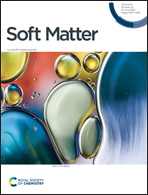Effect of liquid volume fraction and shear rate on rheological properties and microstructure formation in ternary particle/oil/water dispersion systems under shear flow: two-dimensional direct numerical simulation
Abstract
We numerically studied the rheological properties and microstructure formation under shear flow in a ternary particle/oil/water dispersion system. Our numerical simulation method was based on a phase-field model for capturing a free interface, the discrete element method for tracking particle motion, the immersed boundary method for calculating fluid–particle interactions, and a wetting model that assigns an order parameter to the solid surface according to the wettability. The effects of the water-phase volume fraction and shear rate on the microstructure and apparent viscosity were investigated. When the water-phase volume fraction was low, a pendular state was formed, and with an increase in the water-phase volume fraction, the state transitioned into a co-continuous state and a Pickering emulsion. This change in the microstructure state is qualitatively consistent with the results of previous experimental studies. In the pendular state, the viscosity increased with an increase in the water-phase volume fraction. This was due to the development of a network structure connected by liquid bridges, and the increase in the coordination number was quantitatively confirmed. In the case of the pendular state, significant shear thinning was observed, but in the case of the Pickering emulsion, no significant shear thinning was observed. It is concluded that this is due to the difference in the manner in which the microstructure changes with the shear rate. This is the first study to numerically demonstrate the microstructure formation of a ternary dispersion under shear flow and its correlation with the apparent viscosity.



 Please wait while we load your content...
Please wait while we load your content...